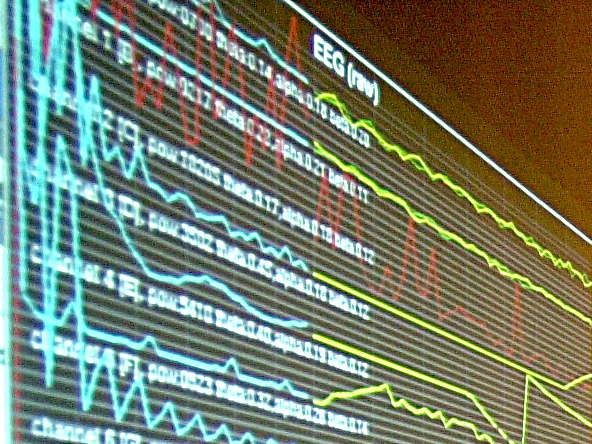
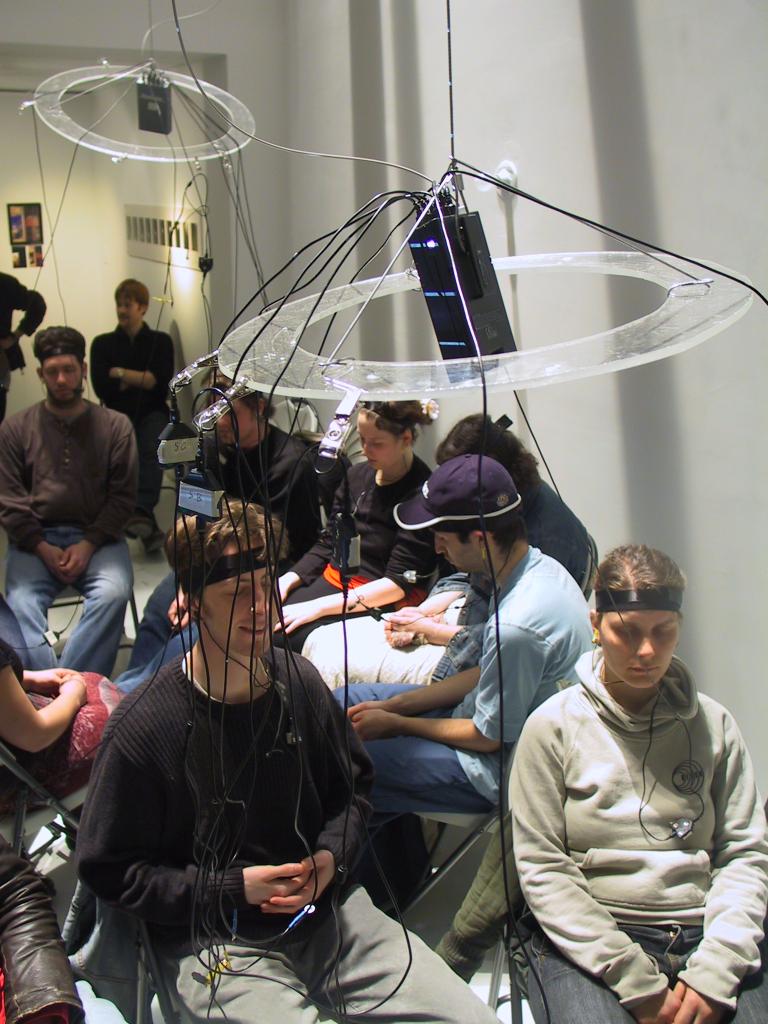
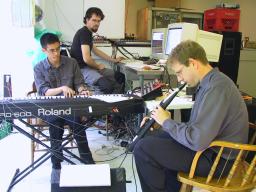
(Public exhibits allow students to showcase their research.)
See also: http://wearcam.org/deconcert/index.htm and http://www.mcluhan.utoronto.ca/blogger/2003_03_01_blogarchive.html#91265586.
Mon, 21 Jul 2003 02:35:59 -0400)
My students and I, along with many others, feel that there is a certain kind of space that we currently lack at University of Toronto. What we feel is presently lacking is a kind of experimental re-configurable research space for passionate individuals and groups to explore unbounded ideas. We were thinking that the 6th floor of Bahen seems like a really good opportunity to create such a new kind of space.
In particular, listening to a number of students, including, but not limited to my own students, there are two main issues regarding existing spaces, such as the the Sandford Fleming grad student lab (SF2202) environment:
Below are some additional notes, thoughts, ideas, etc., that I would welcome your comments on:
Additionally, we could include some research elements in the research space itself, such as:
The second student issue is that students, mainly the grad students, feel that the world is passing them by, when they spend long hours in the lab.
Other groups (various groups at MIT, for example) address this issue by having a kind of space that the students can work in and shape to their own desires, and experiment with. Maximum flexibility is often afforded by the use of structural pipe fittings ("rigging") so that students can, for example, organize creative illumination of the space, and work on creative uses of computer architectures at the macroscopic level. Many of the labs at MIT, CMU, etc., include structural pipe fittings, and not just welded "I" beams, as an integral part of the building's architecture, so that graduate students can easily reconfigure their space.
In addition to reconfigurability by and for grad students, there is also a need for something more general than merely a lab. For lack of an English word to describe such a space, I think of the French word "atelier" meaning a blend between laboratory, workshop, studio, and gallery.
Such a more general kind of space would help free the students of disciplinary boundaries (e.g. labs for science, versus studios for the arts, etc.) and foster a new kind of inventive space+environment.
Along the lines of this second "world passing us by" issue, I noticed that in many Canadian universities, students tended to often buy laptop computers so they could work in a coffee shop, or out in a park, or some space away from their lab, whereas many of the better US universities are characterized by spaces that the students can reconfigure more to their liking. Thus an important difference I notice is that we, here in Canada, spend a lot less time in our labs, than our American counterparts do.
While this may be desirable for some people, there are other people who feel left-out by the lack of a space that they can reconfigure.
Another common desire of students is that they be able to show off their work
to the general public. This can be done by way of public events,
exhibits, etc.. I have experimented, for example, in providing some
of my students with such venues. For example, I created a space where
two of my PhD students could showcase the work, on biosensors, in the
context of a live performance, open to the public, in which there were
approximately 150 attendees.



(Public exhibits allow students to showcase their research.)
See also:
http://wearcam.org/deconcert/index.htm
and
http://www.mcluhan.utoronto.ca/blogger/2003_03_01_blogarchive.html#91265586.
Such a direct interface to the public also helps to contextualize research in a way that can be easily explained to non-technical people, such as those working within funding agencies.
The University has, collectively, a unique skill and expertise at getting things to work, and in creating real change in the world.
In particular, I'd like to discuss an overarching theme, wherein we could direct this expertise at something that would do good for the world, and would also be easy for people to understand and relate to (i.e. fund).
My students, through exposure to the popular press, have developed a very good ability to distill their work down to succinct 30 second soundbytes. This ability will serve them well when it comes time for them to branch out on their own and raise their own funding (e.g. as they graduate to become professors or go out into industry).
Also, the skills that students can develop by presenting their work to the public could also be of great immediate benefit to the university and to themselves.
Thus the students are stakeholders in the lab, and the lab should ideally be an open house for them to show off their work, like a science fair competition but ongoing and continuous.
Examples of projects, and "stuff that matters" to students, regards computers, and the manner in which computer architectures connect to macroscopic architectures.
This would be easy to explore. For example, I note that the 6th floor of Bahen faces out to some roofspace, where we might, for example, create a Heating, Ventilation, and Air Conditioning (HVAC) research space, and implement a "blueroofs" project.
One of the major complaints I hear from students is the excessive air conditioning, and the lack of natural space. A "blueroofs" project would create an outdoor working lab, on the roof, where students could read or work on their portable computers, in nice weather.
In particular, I'd like to re-create the "urban beach" environment we (the grad students) created at MIT.
Such a "labeach" might explore the nexus of teaching, research, living, and work. It was once said "don't mix pleasure and business", but what happens when you do? It was once said don't mix public and private, but what happens when you do?
The labeach is a playful space that captures the youthful energy of running through a sprinkler ("sprayground") while cooling off the entire top floor of the building, thus reducing HVAC load. A fine mist cools the building by evaporation so that the building cools itself much like the human body does (by evaporation of water). Like the greenroofs (rooftop gardens that help keep the roof membrane cool), blueroofs extends the life of the roof's cap sheet (Bahen appears to have a Modified bitumen cap sheet), while saving energy, as a side-effect of a beachlike mist on the roof that could also be enjoyed directly.
Thus instead of taking a laptop computer to the beach (taking the lab to the beach) we bring the beach to the lab. (One of my graduate students is doing research on interactive waterplay spaces, and organized "bodybreaks" exercises among the other students, using the structural pipe fittings as a gym in the workspace --- he has been organizing 5 minute "bodybreaks" every hour or two for the students in the lab, during the day).
The youthful energy of students often manifests itself in an amplified sense of morals and ethics (at least among some students). In particular, we, as scientists, artists, engineers, designers, and inventors, architect the future of a world that is more and more computerized.
But it is the young-at-heart, that, while often naive, are also idealistic, and seek to make the world genuinely better.
One issue that students often raise, is that they feel they are mere cogs in the machinery of engineering, building someone else's (e.g. some company's) universe. Many feel they have little say in the way the computerized+mechanized world around them is architected.
As an example, students feel that card readers and tracking devices are an invasion of their privacy, yet simply accept much of the way the world is "wired" with no sense of self actualization, because they don't feel there's much they can do about it. But suppose, for example, that the students could decide on their own system of lab security access, and create their own environment, as regards to how the temperature of the lab will be controlled, lighting controls, etc., as examples of macroscopic computer architectures.
In my "introduction to microprocessors" (ECE385) course, I have found
that students wish to focus on "stuff that matters" to them.
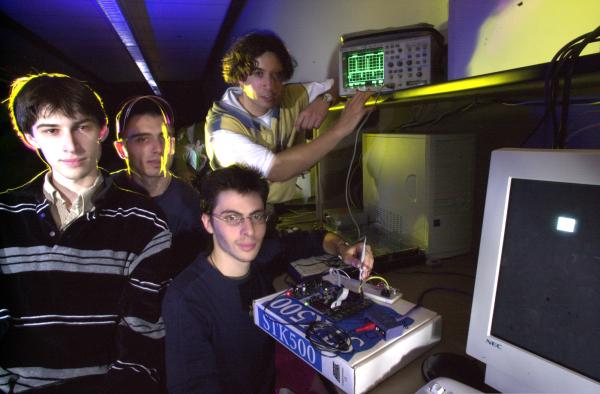
(University of Toronto students in ECE385 lab.)
Thus, for example, when I teach them how to build a card reader, that can read their student "T" card, they get really excited. It is the everyday down-to-earth things that capture their attention more than the big way-out things like space robotics.
One of my students said: "when we realized card readers... I could put this on my front door... really an eye opener, really opens your mind... when you take that course you get a feeling for what university should be.".
While many students like the safety of being a cog in the wheel (like the way a prisoner is guaranteed food), there are others who like to explore, but they don't yet know there's another way (like in "Plato's cave").
With the double cohort, rather than lower our standards to take in more students, perhaps we could simply accept some "genius eccentrics". These are the kind of people who may have low grades but great potential, if given the right work environment.
I find many students are brilliant but nonconformists, who have done poorly in academia because they felt they were "building someone else's universe".
These same students go home and write a compiler in one evening for some new language they invent, and then subsequently fail an assignment because it's not challenging enough.
We need to make a home for geniuses, to expand our numbers without reducing quality of applicants. This would involve simply widening our conceptual window of acceptance, to include nonconformist brilliance.
Note that by "architecture" I mean both physical microscopic (e.g. VLSI, FPGA, etc.), macroscopic (clothing, buildings, etc.), and cyberspace (Internet, etc.) architectures.
ARCHITECTURE:
1 : the art or science of building; specifically : the art or practice of
designing and building structures and especially habitable ones
2 a : formation or construction as or as if as the result of conscious act
b : a unifying or coherent form or structure
3 : architectural product or work
4 : a method or style of building
5 : the manner in which the components of a computer or computer system are
organized and integrated
Archiotics combines macroscopic reconfigurable architectures such as structural pipe fittings with computer architectures, ethernet wiring inside pipes, and novel sensor and effector adaptations to pipe fittings. Prototypes we currently have in place combine three phase lighting with computer technology in the domain of interconnecting pipe fittings that combine mechanical, electrical, and informatic design elements.
Archiotic "smart structures" are made from modified pipe fittings that are Internet enabled. Buildings fitted with structures made from these elements produce "BuildingLogs" (buildinglogs, or "glogs" for short).
Archiotics combines computer architecture, building architecture, as well as the philosophy behind "Architecture of One" (wearable and implantable computing). Thus archiotics exists at the nexus of the individual and the collective, and combines cyborglogs and buildinglogs, in innovative ways.
At the heart of Existential Technologies Research Lab (ETRL) is the speed in which new data structures can be combined with physical structures, to create new applications that combine the physical with the virtual.
Wireless communication along pipe fittings, and the use of the pipe as a waveguide, allow transmission technologies to be used as informatic "plumbing".
Further work will show how pipe fittings can be used to rapidly create hospitals, cities, etc. (like the hospitals that are built in less than a week during an emergency). We have already developed many systems using structural pipe fittings that have been modified to provide electric, informatic, and structural elements in combination.
Hollaender has been kind enough to donate fittings to do some preliminary tests, etc., and this research is ongoing as an example of how microscopic architectures, macroscopic architectures, and cyberspace architectures can merge.
Using a truckload of Atmel AVRs (donated by Atmel Corporation), and other miniaturized computer architectures, we're developing large networks of many small computers. This we feel is the future of computer organization.
In one experimental setup we tried mounting all the lights
outside a building, having them shining in, through the windows, so that
the lighting created a much more natural effect:
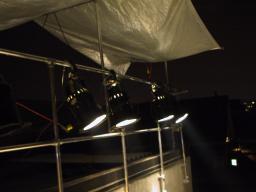
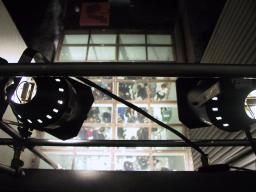
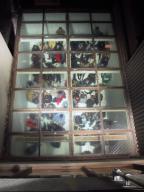
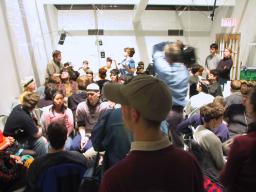
(Energy efficient lighting creates a feeling that the light is alot
brighter than it actually is, because it mimics natural sunlight
using narrowly collimated beams directed from a linear array of outdoor
lights. Brainwave controlled lights can also anticipate the
needs of a building's occupants.)
Taking advantage of the strategic location of the 6th floor of Bahen, we thus would propose an experimental artifical+natural lighting lab/workshop/studio that would have a glass ceiling, allowing in natural light, as well as catwalks and structural pipe fittings ("rigging") at some height above the glass ceiling, upon which outdoor architectural lighting could be installed.
We found that when the light is very pleasant and natural,
less light is needed in order to achieve a good work environment.
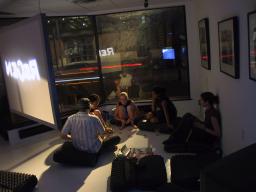
(Students brainstorm new research ideas in an introspective
thought-provoking space. With only 88.4 watts of light power,
the long shadows, localized bright-spots,
and window-frame effect create an environment
that feels warm and pleasant.)
Many other projects exist at the nexus of computer organization and the real world. In particular, I believe that if we were to appeal to the everday "down-to-earth" issues like health care, and everyday life, we could make computer organization relevant to the masses, and therefore attract considerable amounts of funding.